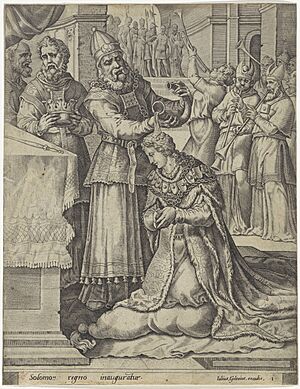Zadok the Priest facts for kids
Zadok the Priest (HWV 258) is a famous British song, called an anthem. George Frideric Handel wrote it for King George II's coronation in 1727. It's one of four special songs Handel created for that event, known as Handel's coronation anthems.
Zadok the Priest is one of Handel's most well-known works. It has been sung at the coronation of every British king or queen since it was first composed. This makes it a very important and recognized British patriotic anthem.
Contents
The Story Behind the Song
The words for Zadok the Priest and Handel's other coronation anthems were chosen by Handel himself. He picked them from an old record of King James II's coronation in 1685.
The lyrics come from the Bible, specifically from the story of Solomon becoming king. In that story, the priest Zadok anoints Solomon. This means he used holy oil to show Solomon was chosen to be king. You can find this story in the Bible, in 1 Kings 1:38-40.
These same words have been used in every English, and later British, coronation since King Edgar's coronation in 973. That event took place at Bath Abbey.
Other composers also wrote music for these words before Handel. For example, Thomas Tomkins might have written a version for King Charles I in 1626. We still have the words from his version, but the music is lost.
Henry Lawes wrote another version for King Charles II in 1661. This was also sung at James II's coronation in 1685.
At King George II's coronation on October 11, 1727, the choir at Westminster Abbey had a few mix-ups. They sang Zadok the Priest at the wrong time during the service. They even forgot to sing one anthem entirely, and another ended in a bit of a mess!
What the Song Says
The words of Zadok the Priest are from the Bible. They are a shorter version of what is written in 1 Kings 1:34-45:
Zadok the priest and Nathan the prophet anointed Solomon king.
And all the people rejoiced and said:
God save the King! Long live the King! God save the King!
May the King live for ever. Amen. Hallelujah.
How the Music is Made
Zadok the Priest is written for a large choir with eight different voice parts (SS-AA-T-BB). It also uses an orchestra. The orchestra includes instruments like two oboes, two bassoons, three trumpets, timpani (kettledrums), and strings. The string section is special because it has three violin parts instead of the usual two.
The music starts with a surprise! The orchestra begins quietly with soft string sounds. Then, suddenly, it bursts into a loud, powerful section with all the instruments playing, especially the trumpets.
The middle part of the song, where the choir sings "And all the people rejoic'd, and said," sounds like a dance. The choir sings together in chords, and the strings play a bouncy, dotted rhythm.
The final section, "God save the King," returns to a steady beat. The "God save the King" part is sung with the choir singing chords. Between these parts, there are "Amen" sections with fast, flowing notes. These fast notes are passed around through the different voice parts of the choir. The song ends with a slow, grand "Alleluia" (Hallelujah).
Where Else You Might Hear It
A composer named Tony Britten changed Zadok the Priest in 1992. He used it as the main idea for the UEFA Champions League Anthem. This is the famous song played before soccer games in the Champions League. Because of this, some soccer fans who didn't know Zadok the Priest thought it was the Champions League song during the Coronation of Charles III and Camilla.
The song was also played during the wedding of Crown Prince Frederik of Denmark and Mary Donaldson. Their wedding happened on May 14, 2004, at Copenhagen Cathedral.
See also
- Handel's coronation anthems


